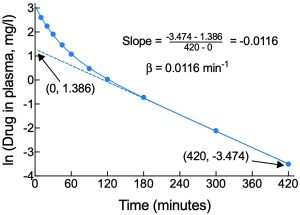Beta (β) rate constant
The first-order rate constant for the exponential elimination of a two-compartment drug from the plasma. It can be found from the slope of the elimination portion of a two-compartment curve (i.e. the straight handle of the hockey stick on a hockey stick curve), which may be facilitated by extrapolating the straight handle of a hockey-stick curve back to the Y-axis, or from the half-life of elimination for a two-compartment drug (from 0.693/half-life). The example shows how to obtain the value of β from the slope of elimination data plotted on a logarithmic Y-axis.

β is a proportionality constant (similar to kel and α) with units of “per time” and indicates the proportion of remaining drug that will be eliminated in unit time (or, similarly, the proportion of the total apparent volume in which the drug is distributed that will be cleared of drug in unit time) if the current rate of elimination is maintained.
While both β and kel are concerned with elimination of drug from the central compartment, β is typically smaller (i.e. yields a longer half life) than an equivalent kel value, because β, but not kel, is impacted by the slow redistribution of drug from the tissues back into the plasma. With a one-compartment drug, redistribution back into the plasma is very rapid and so the elimination from the plasma is able to work as fast as it wants to, without any brake being put on the process due to slow redistribution from the tissues. It is this slow redistribution that also causes a lag leading to the increased tissue:plasma drug concentration ratio observed during the terminal elimination phase, and the value for a drug’s non-compartmental apparent volume of distribution (AVD area) being larger than that for its steady-state apparent volume of distribution (AVD SS).

